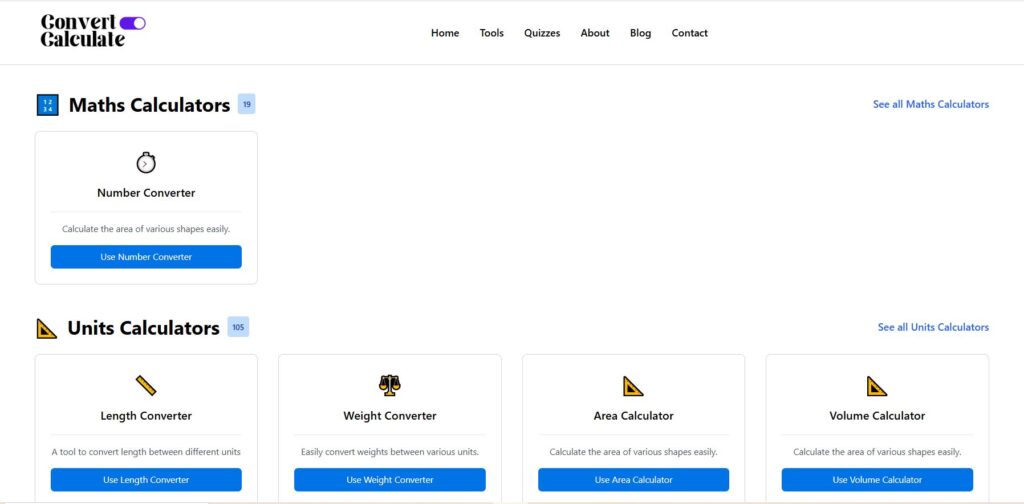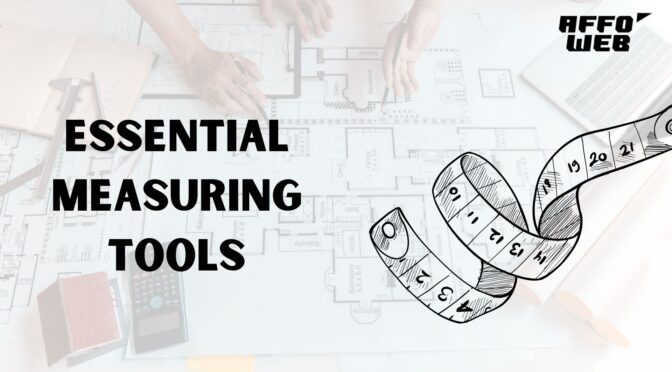Accurate measurement is a cornerstone of efficiency and success across various domains, including education, construction, finance, and everyday activities. Whether you are a professional working in construction or a student managing your academic grades, having the right measuring instruments at your disposal can simplify tasks and improve precision.
ConvertCalculate offers an extensive collection of practical, easy-to-use online measuring tools that cater to these diverse needs. This blog explores a list of 10 common measuring tools and their uses, highlighting their practical applications in daily life, their significance in construction and other fields, and offering a step-by-step guide to using these tools effectively.

1. Length Converter: Simplifying Unit Conversion
Overview
The length converter is a vital tool designed to facilitate conversions between different units of length, such as meters, kilometres, inches, feet, and miles. With global projects and diverse measurement standards, a reliable length converter eliminates confusion and ensures consistency.
Practical Applications
- Construction and Engineering: Ensuring plans and materials are accurately measured, whether the blueprints use metric or imperial units.
- Travel and Navigation: Converting distances for route planning and transportation logistics.
- Education: Helping students understand the relationship between different units of length.
How to Use
- Select the source unit (e.g., meters).
- Enter the value to convert.
- Choose the target unit (e.g., feet).
- Click “Convert” to instantly receive the equivalent measurement.
For teams tracking progress or productivity during large-scale engineering projects, integrating Time Tracking Tools alongside measurement tools enhances transparency and scheduling accuracy.
2. QR Code Generator: Bridging Physical and Digital Worlds
Overview
The QR Code Generator is a versatile tool that creates scannable QR codes capable of storing URLs, text, contact information, and more. It serves a crucial function in the fields of marketing, education, and event coordination.
Practical Applications
- Marketing Campaigns: Linking customers directly to websites, product pages, or promotions.
- Education: Providing quick access to learning materials via a simple scan.
- Event Management: Distributing schedules, maps, or ticket information efficiently.
How to Use
- Input the desired data (e.g., URL or text).
- Customize the QR code’s appearance if necessary.
- Generate and download the QR code for distribution.
QR codes are also increasingly used in Product Analytics Tools to track user interactions and conversions.
3. Weight Converter: Accurate Weight Management Across Units
Overview
The weight converter is an indispensable instrument for converting between various weight units such as grams, kilograms, pounds, and ounces. It ensures precise weight calculations across multiple disciplines.
Practical Applications
- Cooking and Baking: Adjusting recipes that use different weight units.
- Health and Fitness: Tracking body weight or ingredients in desired units.
- Logistics and Shipping: Calculating weight for postage and freight purposes.
How to Use
- Choose the unit you’re converting from.
- Enter the weight value.
- Select the target unit.
- Click “Convert” to get the accurate result.
4. Area Calculator: Measuring Space With Precision
Overview
The area calculator determines the size of two-dimensional spaces such as rectangles, squares, circles, and triangles. It’s essential for property management, landscaping, and interior design.
Practical Applications
- Real Estate: Accurately calculating land or floor space.
- Gardening: Planning the layout and planting area.
- Interior Design: Measuring floor areas for furniture placement or renovations.
How to Use
- Select the shape of the area to calculate.
- Enter the relevant dimensions (length, width, radius).
- Click “Calculate” to determine the area.
5. Volume Calculator: Quantifying Three-Dimensional Space
Overview
Volume calculators compute the capacity of three-dimensional objects such as cylinders, cubes, spheres, and cones. This tool is particularly relevant in construction, manufacturing, and scientific research.
Practical Applications
- Construction: Estimating the volume of materials like concrete or soil.
- Manufacturing: Calculating container capacities or packaging volumes.
- Science and Education: Teaching volume measurement concepts.
How to Use
- Select the three-dimensional shape.
- Enter the necessary dimensions (height, radius, length).
- Click “Calculate” to find the volume.
Protecting student data and education platforms from Cybersecurity Threats is crucial when using online academic tools.
6. Number Converter: Navigating Between Number Systems
Overview
The number converter is designed for converting numbers between various numeral systems such as binary, decimal, octal, and hexadecimal, serving as a key tool for programmers and students.
Practical Applications
- Programming: Interpreting and converting different numeric systems used in coding.
- Education: Helping students grasp the concept of different numeral bases.
- Data Management: Converting formats for technical data processing.
How to Use
- Select the original numeral system.
- Enter the number to convert.
- Choose the target numeral system.
- Click “Convert” to view the result.
7. Grade Calculator: Simplifying Academic Performance Tracking
Overview
The grade calculator provides a quick way to compute final grades based on weighted scores for exams, assignments, projects, and other evaluation components.
Practical Applications
- Students: Tracking academic progress and setting target grades.
- Educators: Calculating overall student performance efficiently.
- Parents: Monitoring children’s academic achievements.
How to Use
- Input the scores for each grading component.
- Enter the respective weight percentages.
- Click “Calculate” to obtain the weighted average grade.
8. ROI Calculator: Evaluating Investment Returns
Overview
The ROI (Return on Investment) calculator helps assess the profitability of investments by comparing the gains to the initial costs, which is critical for making informed financial decisions.
Practical Applications
- Businesses: Determining the success of marketing campaigns or capital investments.
- Personal Finance: Evaluating returns on personal stock or property investments.
- Financial Advisors: Assisting clients with investment planning.
How to Use
- Enter the initial investment amount.
- Input the final return or current value.
- Click “Calculate” to see the ROI percentage.
9. Simple Interest Calculator: Understanding Interest on Principal
Overview
This calculator computes simple interest, which is the interest earned on the original principal over a period at a fixed rate, helping users manage loans and savings.
Practical Applications
- Loan Calculations: Estimating interest payments on personal or business loans.
- Savings Planning: Understanding returns from fixed deposits or savings accounts.
- Education: Teaching financial literacy concepts.
How to Use
- Enter the principal amount.
- Specify the interest rate.
- Input the time period.
- Click “Calculate” to find the interest earned.
10. Compound Interest Calculator: Measuring Growth on Growth
Overview
The compound interest calculator extends beyond basic interest calculations by factoring in interest earned on previously accumulated interest, demonstrating how investments can grow at an accelerating rate over time.
Practical Applications
- Long-Term Investments: Planning retirement funds or education savings.
- Business Finance: Projecting the future value of reinvested profits.
- Education: Demonstrating the power of compound interest in finance classes.
How to Use
- Enter the principal amount.
- Input the interest rate.
- Specify the number of compounding periods per year.
- Enter the total investment duration.
- Click “Calculate” to obtain the compounded interest and total amount.
Modern AI-Based Testing Tools are beginning to automate financial modeling and forecasting, which complements tools like ROI and interest calculators.
Practical Applications of Measuring Tools in Daily Life
Measuring instruments play an integral role in everyday activities beyond specialized fields. From adjusting recipes using weight and volume converters to calculating academic scores with grade calculators, these tools empower individuals to make informed decisions with precision.
In construction and engineering, these tools become even more critical. Accurate length and area measurements ensure that buildings are constructed according to specifications, while volume calculations help estimate materials required, preventing wastage and reducing costs.
Finance professionals and individuals alike benefit from ROI, simple interest, and compound interest calculators, making sense of complex financial concepts and planning investments with clarity.
Measuring Instruments Used in Construction and Their Functions
Construction demands precise and reliable measuring instruments to ensure safety, functionality, and cost efficiency. Among the tools discussed:
- Length Converter: Converts units from imperial to metric to align blueprints and materials.
- Area Calculator: Measures floor and land space for designing layouts and compliance.
- Volume Calculator: Estimates quantities of materials like concrete, gravel, and water tanks.
Using these measuring instruments accurately translates into better project management, fewer errors, and higher quality construction outcomes.
Step-by-Step Guide to Using Measuring Tools on ConvertCalculate
Utilizing these measuring tools online at Convert Calculate is intuitive. Here’s a general guide:
- Select the Appropriate Tool: Identify the measuring tool based on your task—whether it’s length conversion, grade calculation, or ROI evaluation.
- Input Data Accurately: Enter all necessary values such as dimensions, rates, or grades. Precision here is key to accurate results.
- Choose Relevant Units or Options: Many tools require selecting source and target units or grading weights.
- Execute the Calculation: Click the “Convert” or “Calculate” button to process your input.
- Review and Apply Results: Use the output to make informed decisions or continue with your work.
Each tool includes help tips and examples to guide new users, making it accessible even for beginners.
Conclusion
From education to construction, finance to everyday tasks, the ability to measure and calculate precisely impacts success and efficiency. The list of 10 common measuring tools and their uses presented here—available at ConvertCalculate—provides a comprehensive solution for your measurement needs.
Whether you need to convert lengths, calculate areas, generate QR codes, or evaluate investments, these tools are designed for accuracy, ease of use, and broad practical applications. Embrace the power of technology to streamline your measurements and calculations with ConvertCalculate.
Explore these measuring instruments today and experience the convenience of precise, professional-grade online tools tailored for every need.
